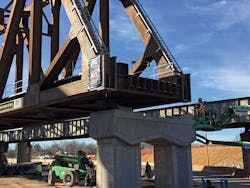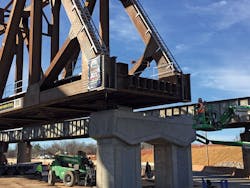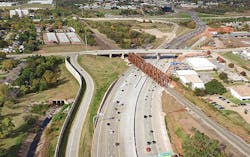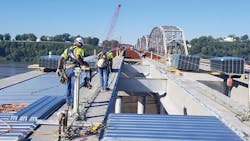Region Report: Oklahoma & Missouri
OKLAHOMA:
Staying vigilant
“Oklahoma has a larger bridge system than Colorado or Florida. Most people don’t consider that.”
Oklahoma Department of Transportation (OKDOT) Public Relations Chief Terri Angier made this remark in her interview with Roads & Bridges almost as a throwaway statement, yet it resonates quite soundly, when one considers what she went on to say: “In 2005, we had about 1,200 on-system (state-maintained) structurally deficient bridges. Today, that number is 155, and by 2020 we plan to have each of those bridges in our program to be addressed.”
According to the most recent FHWA data, Oklahoma sits pretty much in the middle of statewide condition rates for its overall bridge system, with 12% of bridges considered to be in “poor” condition. The bulk of this figure resides on the local or secondary system, considered to be “off-system.” And here is where decades of funding reappropriation continues to demonstrate its radiative and deleterious effects.
“There was a time,” Angier said, “where we were No. 1 in diverting transportation revenue to other avenues. For decades, this was a true statement—and it was extremely disturbing. This dates back to the 1950s, and then the interstate system was placed on top of that, so funding had to stretch even further, but it did not increase. In fact, dollar for dollar, we regressed.”
Setting the BNSF rail overpass on the piers. Image: Oklahoma DOT
In 1985, OKDOT received $209 million from its legislature for road and bridge planning, building, maintenance and operations. In 2005, that figure sat at $200 million flat—despite inflation. And according to Angier, it certainly showed in the condition of the state’s roads and bridges.
“There was a direct correlation between funding going down and the condition of roads and bridges going down,” she said. Now that progress is being made, Angier is hopeful that a stark reverse trend will become apparent, but concedes that decades of avoidance cannot be fixed on the double.
“In the 10-12 years since our funding has begun to reverse and grow, we’re seeing real progress—but five decades of underfunding isn’t going to be solved by one decade of focus and improvement.”
The transportation system in Oklahoma is largely rural with isolated pockets of dense urban growth—notably Tulsa and Oklahoma City. Across 77 counties and serving a population of nearly 4 million, the state system’s 31,000 lane-miles and 6,800 bridges represent a cumulative $60 billion asset. And with heavy freight traffic holding at 15% statewide (peaking at 30% on U.S. 69), resulting mainly from the agriculture, energy, oil/gas and aviation industries, pavement conditions are an ever-present concern. FHWA has categorized nearly a quarter of state roads as “poor,” a fact OKDOT is all too aware of—and which will be the focus of the state’s eight-year plan update.
An aerial view of the I-235/U.S. 77 project site in Oklahoma. Image: Oklahoma DOT
“Our strategy with our eight-year plan,” Angier said, “is to place the focus on three different aspects of road improvement. First, maintaining what we’ve got and extending lifespan. Second, reconstruction, especially due to those decades of neglect and the initial focus on dealing with our bridges. And third, inadequate shoulders. We have 4,400 miles of two-lane highway with inadequate shoulders. We want to have a comprehensive approach to all three of these areas at once, not just one over the other.”
With multiple packages letting statewide and several projects ongoing, including the $88 million reconstruction of I-235/U.S. 77 between I-44 and North 36th in Oklahoma City, it looks as though the turnaround for Oklahoma is coming on at full speed.
“We can finally, for the first time, talk about a vision for our transportation system,” Angier said. “And that vision is that we will be finished with all known SD bridges and make a huge improvement on our pavement conditions, to make us competitive for the best roadway system in the U.S. So long as the roads are open, you never really finish your program, so we have to remain vigilant. We’ll never put a bow on the package and say we’re done. The good news is that by 2025, we want to be out of the red and into the black.”
MISSOURI:
In a bind
Missouri Department of Transportation (MoDOT) Director Patrick McKenna cut concisely to the gist of what will result from the recent failure of Proposition D, a bill that would have enacted a gradual 10-cent-per-gallon gas tax increase and generated some $123 million annually for local roads and bridges, and $288 million for those state-managed: “When we don’t have a long-term funding source, we can’t project out a schedule on major projects that have multi-year contracts.”
Proposition D was, in many corners of government, expected to pass, even though Missouri is a state traditionally averse to accepting new or various forms of taxation—e.g., tolling is more or less a nonstarter. And in the wake of its failure to pass, despite 1.1 million votes in its favor, MoDOT now finds itself in a murky position, with a significant amount of work needing to be done and just not enough money to do it.
“We are nowhere near the level of capital we need,” McKenna told Roads & Bridges. “We’re at half the topline capital we need. And since we haven’t raised the gas tax since 1996, spending power is half what it was.”
Missouri is a large state, both in population and sheer mileage. The state system contains 34,000 miles of road and 10,400 bridges; the secondary/local system adds 97,000 road miles and 14,000 bridges. Add to that a complicated water and barge system and several active rail hubs, and what you have is an asset that very quickly could become a detriment.
Crews check deck pans in preparation for a deck pour on the Champ-Clark Bridge. Image: Missouri DOT
“We have an extraordinary number of bridges that were built in the 1930s, ‘50s and ‘60s,” McKenna said. “We’ve done a fairly good job of replacing the ones built in the ‘30s, but what we have coming forward is a kind of tidal wave of square footage on all those bridges built in the ‘50s and ‘60s, and those are all coming due pretty substantially now. We look at it in terms of sq ft of bridge deck; in the last 20 years we’ve replaced 1.2 million sq ft of bridge deck, mostly based on age and condition. We project that in the next 20 years, that number will need to triple in order to keep pace with what’s coming up on the end of its design life. So, we have significant bridge work ahead of us far exceeding the available funding.”
As with all states, much funding reliance comes from the federal government, but that creates its own concerns. “The present administration is signaling there won’t be general revenue support for the Highway Trust Fund,” McKenna said, “which will require Congressional action to address, and that’s an estimated $19 billion gap by 2021. That could be a very significant reduction in federal funding, and the effect on construction planning for states can be assumed.” McKenna went on to prescribe what is needed at the federal level in order to avoid or at least assuage a catastrophic fiscal crisis. “There are two things that need to happen at the federal level. The FAST Act is only funded through 2020, but the fifth year was funded with a recision of $7.5 billion. Congressional action is going to be needed to deal with that, or most likely there will be impacts to construction projects for all states. In Missouri, we’re looking at a possible $120 million impact in 2020. We have to make some assumptions in order to even move forward; hopefully the government will take the right kind of action.”
Despite these looming concerns, MoDOT has been keeping up a vigorous maintenance program, which always is a primary concern due to the massive amount of regular icing that occurs on its roads. “We average $50 million for the winter budget each year,” McKenna said, “but it can fluctuate from $25 to $75 million. We do a good job of material management, reducing our reliance on salt, increasing brining techniques, and we also use a beet-derived product where the sugars attach to chloride and we get good surface traction that way.” But it is less the state system than the secondary that will be directly affected if funding sources are not secured. “On our lowest-volume roads, we don’t have a standard hot-mix program,” McKenna said. “We have our maintenance crews triaging and patching those roads, doing surface treatments, which is probably not what citizens prefer, things like chip seals and cold patching to stay ahead of the declination curve. We’re frankly just trying to hold that part of the network together.”
The Champ-Clark project in Missouri will remove a potential 77-mile detour. Image: Missouri DOT
Nonetheless, several projects are coming to fruition, notably on the bridge network, that will have a major impact on the motoring public. In northeastern Missouri, the Champ-Clark Bridge project is replacing a 100-year-old bridge; the significance of this project lies in the fact that, without this new structure, the local communities would face a 77-mile detour. In St. Louis, the I-64/I-55 Poplar Street Bridge and ramp project is ongoing; improvements are being made on the eastbound bridge, and crews are placing a new overlay as well as widening the ramp from northbound I-55 to the bridge. And in the city of Washington, the deteriorating 1936 Missouri River Bridge on I-47 is being replaced in a $70 million project partially funded by a TIGER grant. Ribbon cutting to open the bridge took place on Dec. 1.
“We also did one of the largest bridge slides in U.S. history, on the 1,200-ft Poplar Street Bridge, where we split the existing structure and are building a lane in between the two,” McKenna said. “It’s an innovative technique there. We look for those opportunities.”




